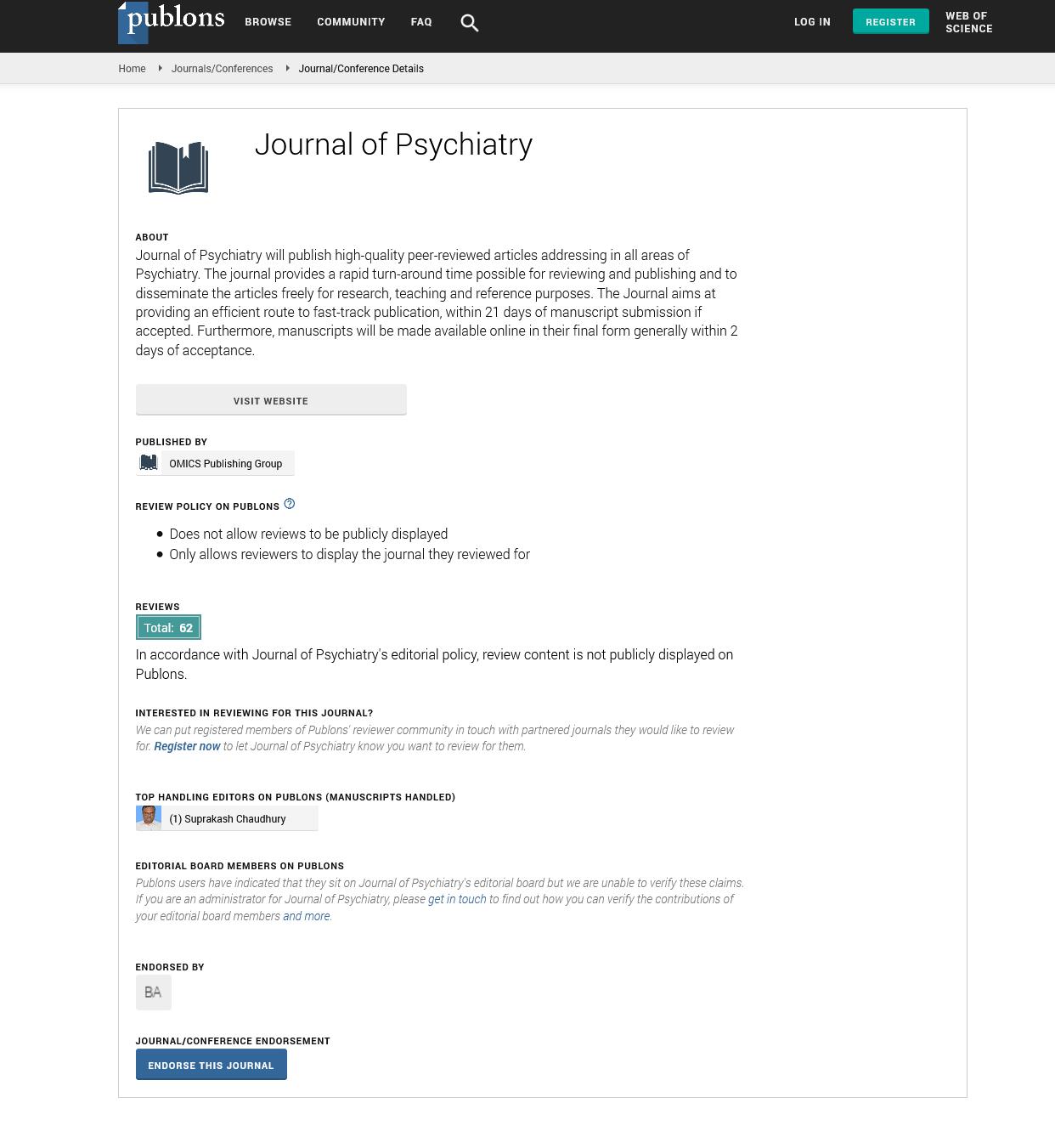Indexed In
- RefSeek
- Hamdard University
- EBSCO A-Z
- OCLC- WorldCat
- SWB online catalog
- Publons
- International committee of medical journals editors (ICMJE)
- Geneva Foundation for Medical Education and Research
Useful Links
Share This Page
Open Access Journals
- Agri and Aquaculture
- Biochemistry
- Bioinformatics & Systems Biology
- Business & Management
- Chemistry
- Clinical Sciences
- Engineering
- Food & Nutrition
- General Science
- Genetics & Molecular Biology
- Immunology & Microbiology
- Medical Sciences
- Neuroscience & Psychology
- Nursing & Health Care
- Pharmaceutical Sciences
Opinion Article - (2025) Volume 28, Issue 2
Beneath the Silence: Digital Phenotyping as a Lens into Adolescent Depression
Emine Kara*Received: 24-Feb-2025, Manuscript No. JOP-25-28816; Editor assigned: 26-Feb-2025, Pre QC No. JOP-25-28816; Reviewed: 12-Mar-2025, QC No. JOP-25-28816; Revised: 18-Mar-2025, Manuscript No. JOP-25-28816; Published: 26-Mar-2025, DOI: 10.35248/2167-0358.25.28.739
Description
Adolescence is a stage marked by significant emotional, psychological and social changes. For many young people, this period includes challenges that can feel overwhelming. While occasional sadness or mood swings are common, persistent low mood, social withdrawal and loss of interest in daily activities may indicate depression. Detecting these signs early is essential, but it’s not always easy. Teenagers may be reluctant to talk about how they feel, or they may not fully understand what they’re experiencing themselves. In this context, digital phenotyping has become a subject of growing interest in the effort to better understand mental health during these formative years. Digital phenotyping refers to the process of collecting and analyzing data from personal digital devices especially smartphones and wearables to gain insight into behavioral patterns. These devices track a wide range of information: movement, communication, sleep habits, screen time and even voice usage. When viewed over time, these small data points can reflect changes in mood, energy levels and social interaction, all of which are relevant in identifying signs of depression.
For adolescents, smartphones are an especially central part of life. They are used not just for communication but also for entertainment, learning and self-expression. Because of this, digital traces left behind can serve as a mirror of daily experiences. For instance, a noticeable drop in texting, fewer calls, or less time spent on favorite apps might reflect a shift in social interest or motivation. Similarly, increased late-night usage could point to sleep disruption, a common feature of depression. Location tracking has also been used to study patterns in daily activity. Reduced mobility such as spending more time at home or avoiding school and social settings may reflect changes in emotional state. It's not about a single event but rather the consistency of behavior over days or weeks. When someone who was previously active begins to withdraw or isolate, that shift can carry emotional significance. The goal of digital phenotyping is not to label individuals or replace clinical evaluations. Instead, it serves as a tool that can support early awareness. When unusual patterns emerge, they might encourage a conversation between a teenager and a trusted adult or mental health professional. In cases where teens are not openly discussing how they feel, this approach can help prompt earlier outreach or support.
Educators and healthcare providers may also find value in these tools, especially when used in collaboration with other methods of assessment. A sudden drop in school engagement, increased absences, or complaints about sleep or focus might align with changes in digital behavior. Recognizing these signs as part of a larger picture can improve responses to emotional distress. Parents may worry that monitoring their child’s digital life could be invasive, but when done transparently and respectfully, it can also be seen as an act of care. In many cases, the goal is not constant surveillance but a broader understanding of well-being. Rather than reacting only when a crisis occurs, digital phenotyping offers the chance to notice changes earlier, when support can be more effective. Research in this area is ongoing. Scientists are working to improve the accuracy of predictions, reduce false signals and make the tools more accessible. As more is learned, the approach may become part of standard practice for identifying early signs of emotional difficulties in young people. While technology alone cannot solve mental health challenges, it can offer another way to understand them. Through the passive observation of day-to-day behaviors, digital phenotyping opens a new window into how adolescents may be feeling even when they’re not saying much. When used thoughtfully, it can help create safer, more responsive environments for teens who are struggling quietly.
Citation: Kara E (2025). Beneath the Silence: Digital Phenotyping as a Lens into Adolescent Depression. J Psychiatry. 28:739
Copyright: © 2025 Kara E. This is an open-access article distributed under the terms of the Creative Commons Attribution License, which permits unrestricted use, distribution and reproduction in any medium, provided the original author and source are credited.

